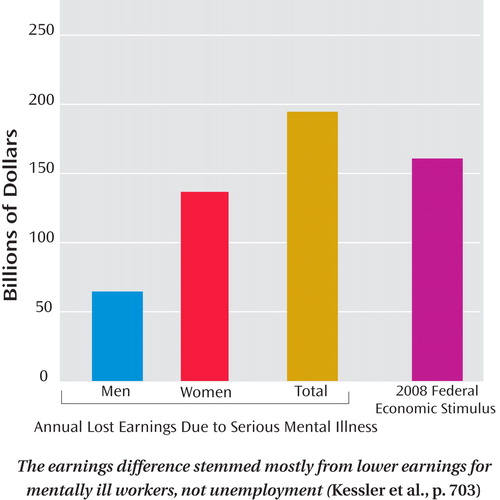In This Issue
Lower Earnings for the Mentally Ill
Average annual earned income for people with serious mental illness was $16,306 less per person than for others in 2001–2003. The analysis of data from the National Comorbidity Survey Replication by Kessler et al. (CME, p. Original article: 703 ) reveals that only one-fourth of the lost earnings was due to unemployment among respondents with serious mental illness. Most was accounted for by lower earnings among the employed. Serious mental illness was assessed for the 12 months preceding the survey interview and was defined as nonaffective psychosis, bipolar disorder, seriously impairing depression or panic disorder, serious suicide attempt, impulse control disorder with repeated serious violence, or other disorder causing 30 days or more of missed role performance. The total lost earnings for the entire U.S. population of seriously mentally ill are estimated as $193 billion, more than this year’s federal economic stimulus payments. Dr. Thomas Insel discusses the total economic cost of serious mental illness in an editorial on p. Original article: 663 .

Antisocial Adolescents Have Blunted Brain Response to Others’ Fear
The amygdala is thought to be the brain’s fear center, but it does not respond normally in adolescents who have callous and unemotional traits and disruptive behavior. While 12 of these adolescents viewed pictures of faces with fearful expressions, functional magnetic resonance imaging showed less response in the amygdala than was observed among healthy adolescents. Marsh et al. (CME, p. Original article: 712 ) found no difference in response to angry facial expressions or among adolescents with attention deficit hyperactivity disorder, another condition characterized by impulsiveness and irresponsibility. Impairment in behavioral responses to distress cues like fearful expressions is suggested by the relationship between activation of the amygdala and the ventromedial prefrontal cortex, which was weaker in the adolescents with callous-unemotional traits than in the two other groups. Dr. Mairead Dolan considers the implications in an editorial on p. Original article: 668 .
ADHD Treatments Go Head to Head
A large, double-blind comparison of the two major types of drug treatments for attention deficit hyperactivity disorder (ADHD) demonstrated a higher response rate for osmotically released methylphenidate, a stimulant, than for atomoxetine, a noradrenergic inhibitor. Both were markedly superior to placebo, however, and atomoxetine was subsequently successful for 43% of the patients whose symptoms did not respond to the initial methylphenidate trial. The study by Newcorn et al. (p. Original article: 721 ) included 516 patients ages 6 to 16, who received the first treatment for 6 weeks. Switching both the methylphenidate responders and nonresponders to atomoxetine for another 6 weeks revealed that one-third of the patients responded to one of the medications but not both. Implications for clinical decision making are discussed by Dr. Benedetto Vitiello in an editorial on p. Original article: 666 .
Brain Stimulation Following Cingulotomy
A patient with long-standing severe depression experienced only 6 months of remission after cingulotomy, but after deep brain stimulation her improvement has lasted 2.5 years. Neimat et al. (p. Original article: 687 ) describe the woman’s previous treatment with medication and electroconvulsive therapy and provide details of the brain surgery and stimulation. The successful treatment targeted the subgenual cingulate, which has been implicated in major depression by functional neuroimaging studies. Implantation of the electrodes allowed adjustments to maximize the patient’s response. Improvement progressed over the next year, and she has resumed regular activity. Although deep brain stimulation cannot be unambiguously identified as the critical therapeutic element, the authors’ earlier pilot study of the same procedure produced a response in four of six patients. Dr. Stuart Yudofsky reviews neurosurgical interventions for depression in an editorial on p. Original article: 671 .



